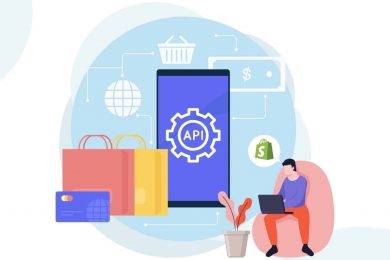Nowadays eCommerce has grown both vertically and horizontally. And this pandemic situation has given a boost to the overall e-commerce business. E-commerce does not just refer to selling the products through different channels, it is all about providing the customers with a seamless experience in shopping online be it on a mobile, laptop, or any digital device.
The online shopping experience on the e-commerce website can only be smooth when the back-end details of finance, stock, and inventory, customer service management which is fed in the ERP can respond in real-time to the e-commerce platform.
The e-commerce integration is possible only if there is complete coordination between a company’s website and their back-end operations like accounting & ERP systems. API Integration for eCommerce provides the end-users with smooth surfing of the website.
What are the Advantages of integrating ERP in the e-Commerce Business?
- ERP which refers to Enterprise Resource Planning is where the main processes of the businesses are integrated which contributes to the systematic growth of the management. Below mentioned are few benefits of using the ERP:
- It reduces the administrative and operational costs
- Adds security layer to the company’s data and information
- Provides accuracy in the company’s data
- Supports accurate forecasting
- Inter-department transfer becomes convenient
- Data is accessible from any part of the world.
- The high level of automation increases productivity.
Challenges Faced while Integrating the ERP with E-commerce:
The integration of ERP and E-commerce platforms is not just restricted to the mutual transfer of data. It is a process of integrating all the complex business processes for leveling up one’s business.
Although it’s a very useful and profitable process but involves complexities at different levels and it is very important for the company to understand the issues and sort them accordingly for the successful eCommerce and ERP integration.
Below mentioned are some of the challenges faced while integrating ERP and e-commerce:
1) Not very clear about the requirements
It often happens that once it is decided to integrate e-commerce and ERP, the business owners do not give enough time to the Integrating team as they leave everything over them. And here starts the problem as the integrating team is not very clear about their understanding so they work aimlessly.
This ultimately leads to delay in project delivery, unsatisfied with the output, efforts increase, cost shoots up and other issues.
So, the business owner and integration partners should have an elaborate discussion so that the integrators are very clear about the neat, clean understanding of the major requirements.
Once the requirement is clear, the integrators are aware of most of the challenges that they would be facing so they know how to tackle those as they are clear on the vision of the company.
Here comes the use of Workflow management which helps to manage the complete flow of business. The detailed presentation of the layout of different processes will give concise knowledge to the integrators.
2) Pricing structure followed by the company
Every organization has a different pattern of pricing and cost structure. Somewhere synchronization of different categories is required like price groups, price level, customers price list, open balance, balance credit. These details should come from E-commerce directly in the ERP.
This makes the overall management of the pricing and costing quite easier.
3) Integrating with the clear intention
Before the process of integration is initiated, the intention of the business owner should be very clear.
The owner should have quantitative expectations like growth in sales figures, increase in the number of customers, increase in the percentage of profit, etc.
The qualitative improvements shall also be there, but the integration’s success would be measured by these quantitative parameters only.
4) Shipping terms
On one hand when the ERPs are very flexible that it accommodates the details of multiple shipment locations, multiple deliveries, multiple warehouses, multiple countries, multiple shipping routes, etc. Shipping API Integration includes some other details which it supports are Full Truck Load (FTL), Less than Load (LTL), etc.
Nut, on the other hand, E-commerce solutions are not that adaptable, thus, one needs to make sure that the shipping patterns which are available in ERP should be present in the E-commerce platform as well.
5 ) Neglecting the testing of integration
Testing is one crucial step that is done to ensure that the integration done between E-commerce and ERP is working and helping to reap the benefits to the organization.
But even this step is neglected many times and the projects are considered successful without even doing the testing.
Testing helps to identify how well the integration is done and how it is synchronizing with the business process and making things happen in a better way.
6) Integrate for long-term profit
If one is looking for a successful result then the integration should be considered as a long-term project which shall give them benefit continuously.
The short-term goals can be achieved quickly but are not long-lasting and hence can be dangerous to the organization. When noting down the requirements to be met in integration, it should be done considering the future so that all the changes in business processes made in the future are easily adapted in the integrated system.
7) Promotions cannot be synched
Integrating the promotion programs between ERP and eCommerce will not be possible as both follow different formats and rules.
The online promotion and advertisement are handled and managed by the side of the E-commerce section only and it will flow to the ERP via the sales order only in the form of line-item discount or overall order discount.
Thus, here stands a challenge in managing the orders which are placed over the phone and to make sure that the customers have a provision to enter the same discount coupon and code as on the e-commerce platform.
8) Providing training
As the integrated system is new, so the users need to be trained on how to use it efficiently. Thus, the management should look into conducting training first before working on the integrated system.
Adequate training will help them to understand the changes and how can they work on the same which can ultimately contribute to the profitability of the company.
Now, even if the ERP and eCommerce are successfully integrated, if the people who are running the tools are not trained, then all the efforts and money invested will go in vain. It will ultimately lead to the overall failure of the project.
-Hence, adequate training is a must for sustained growth of the integrated system.
9) The closely assembled applications
It is a fact that when the integration of ERP and E-commerce is done then the different applications are intertwined so closely that they become very difficult to adapt to any kind of changes in the future, hence, one should try to keep a few aspects completely independent.
Such stiff integration also makes the process of migration very difficult for such applications.
Conclusion:
The above points clearly explain the challenges which one comes across while integrating the ERP with the E-commerce platform. But the more they spend time on the upfront and more they communicate with the business owner, the more challenges will be easily resolved.
Also, more critical thinking and in-depth knowledge about the business processes will help to tackle these issues in a great way and will result in a successful project.
I am Jones Smith and I am here to share my experience and expertise in writing. I’ve been writing articles for different publications for more than 6 years. I have a varied range of interests and that’s why I love blogging about different topics. In my opinion, blogging is a lot like acting, and I consider writing blog posts as an acting job. I am an entrepreneur by heart and there is nothing big or small when it comes to starting a business.











